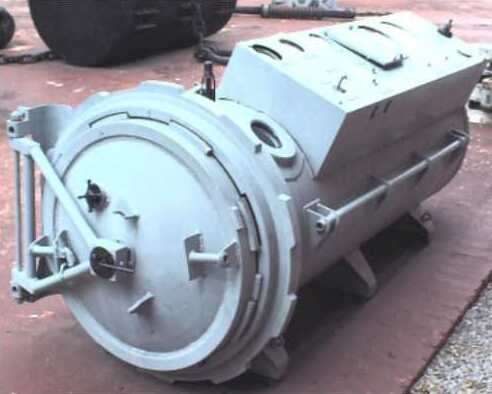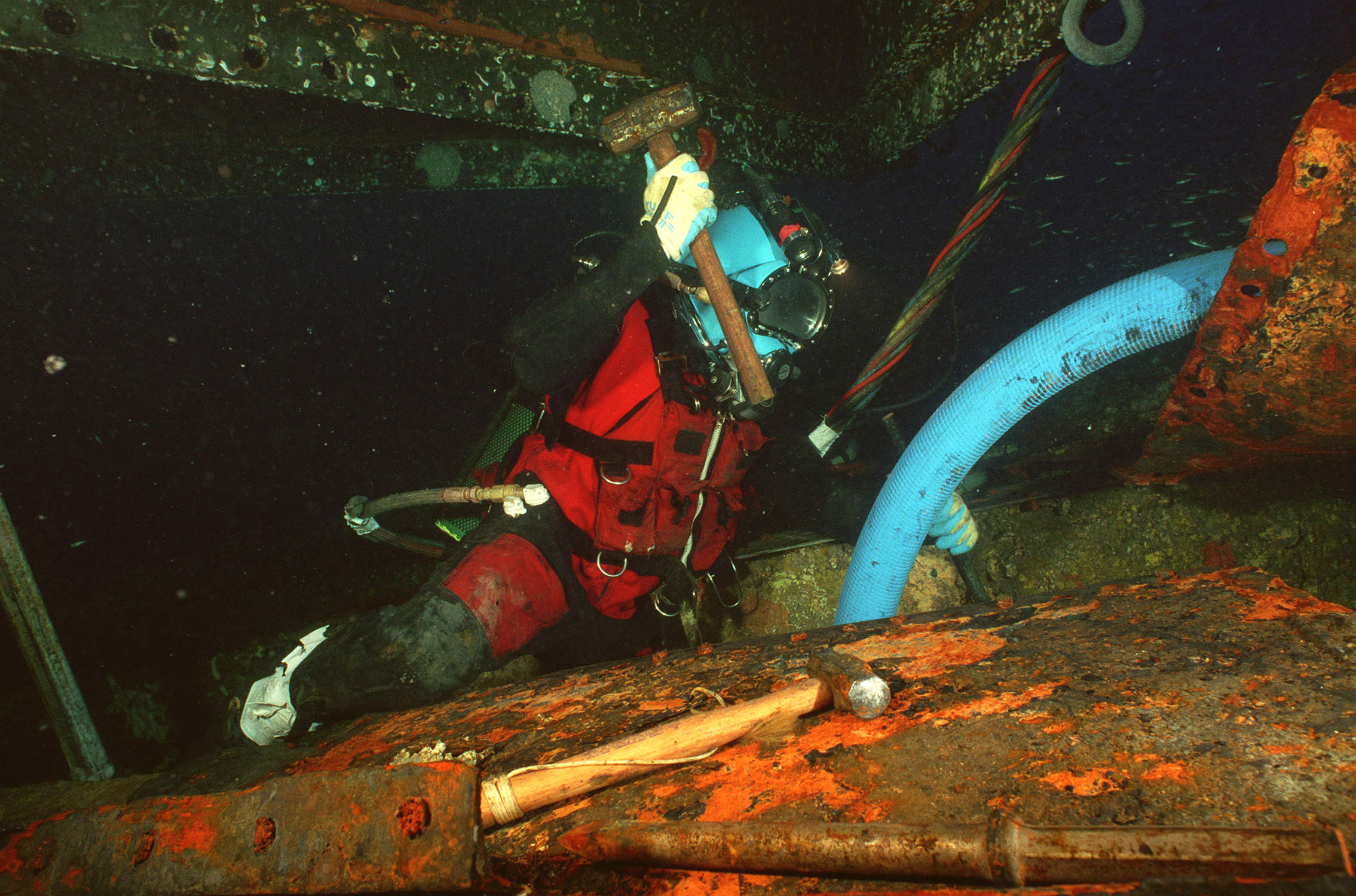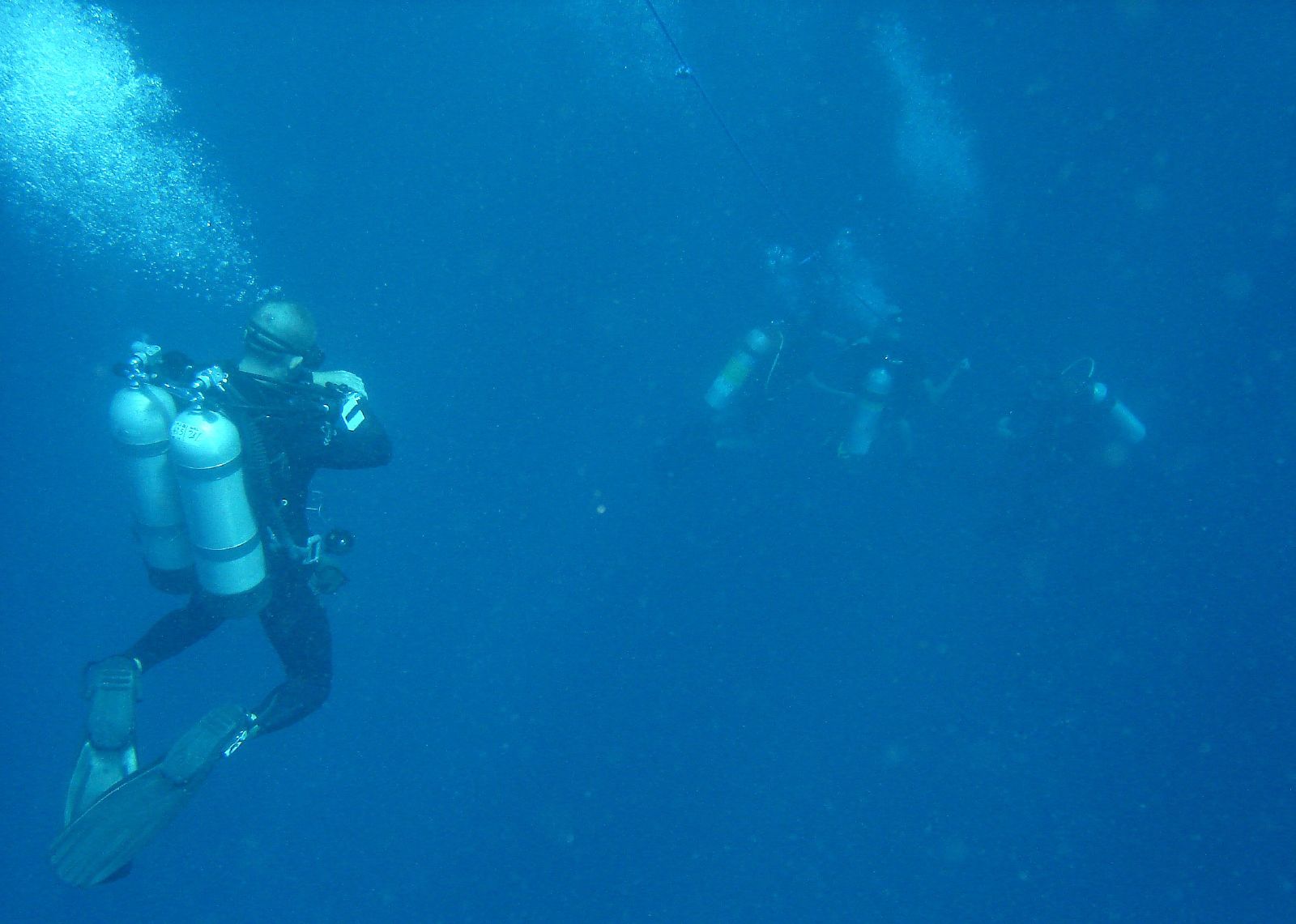|
Isobaric Counterdiffusion
In physiology, isobaric counterdiffusion (ICD) is the diffusion of different gases into and out of tissues while under a constant ambient pressure, after a change of gas composition, and the physiological effects of this phenomenon. The term inert gas counterdiffusion is sometimes used as a synonym, but can also be applied to situations where the ambient pressure changes. It has relevance in mixed gas diving and anesthesiology. Background Isobaric counterdiffusion was first described by Graves, Idicula, Lambertsen, and Quinn in 1973 in subjects who breathed one gas mixture (in which the inert component was nitrogen or neon) while being surrounded by another (helium based). Clinical relevance In medicine, ICD is the diffusion of gases in different directions that can increase the pressure inside open air spaces of the body and surrounding equipment. An example of this would be a patient breathing nitrous oxide in an operating room (surrounded by air). Cuffs on the endotrach ... [...More Info...] [...Related Items...] OR: [Wikipedia] [Google] [Baidu] |
Physiology
Physiology (; ) is the science, scientific study of function (biology), functions and mechanism (biology), mechanisms in a life, living system. As a branches of science, subdiscipline of biology, physiology focuses on how organisms, organ systems, individual organ (biology), organs, cell (biology), cells, and biomolecules carry out chemistry, chemical and physics, physical functions in a living system. According to the classes of organisms, the field can be divided into clinical physiology, medical physiology, Zoology#Physiology, animal physiology, plant physiology, cell physiology, and comparative physiology. Central to physiological functioning are biophysics, biophysical and biochemical processes, homeostasis, homeostatic control mechanisms, and cell signaling, communication between cells. ''Physiological state'' is the condition of normal function. In contrast, ''pathology, pathological state'' refers to abnormality (behavior), abnormal conditions, including human diseases. ... [...More Info...] [...Related Items...] OR: [Wikipedia] [Google] [Baidu] |
Underwater Diving
Underwater diving, as a human activity, is the practice of descending below the water's surface to interact with the environment. It is also often referred to as diving (other), diving, an ambiguous term with several possible meanings, depending on context. Immersion in water and exposure to high ambient pressure have Physiology, physiological effects that limit the depths and duration possible in ambient pressure diving. Humans are not physiologically and anatomically well-adapted to the environmental conditions of diving, and various equipment has been developed to extend the depth and duration of human dives, and allow different types of work to be done. In ambient pressure diving, the diver is directly exposed to the pressure of the surrounding water. The ambient pressure diver may dive on breath-hold (freediving) or use breathing apparatus for scuba diving or surface-supplied diving, and the saturation diving technique reduces the risk of decompression sickness ... [...More Info...] [...Related Items...] OR: [Wikipedia] [Google] [Baidu] |
Hyperbaric Medicine
Hyperbaric medicine is medical treatment in which an increase in barometric pressure of typically air or oxygen is used. The immediate effects include reducing the size of gas emboli and raising the partial pressures of the gases present. Initial uses were in decompression sickness, and it also effective in certain cases of gas gangrene and carbon monoxide poisoning. There are potential hazards. Injury can occur at pressures as low as 2 psig (13.8 kPa) if a person is rapidly decompressed. If oxygen is used in the hyperbaric therapy, this can increase the fire hazard. Hyperbaric oxygen therapy (HBOT), is the medical use of greater than 99% oxygen at an ambient pressure higher than atmospheric pressure, and therapeutic recompression. The equipment required consists of a pressure vessel for human occupancy ( hyperbaric chamber), which may be of rigid or flexible construction, and a means of a controlled atmosphere supply. Treatment gas may be the ambient chamber gas, or delivered ... [...More Info...] [...Related Items...] OR: [Wikipedia] [Google] [Baidu] |
Bühlmann Decompression Algorithm
The Bühlmann decompression model is a neo-Haldanian model which uses Haldane's or Schreiner's formula for inert gas uptake, a linear expression for tolerated inert gas pressure coupled with a simple parameterised expression for alveolar inert gas pressure and expressions for combining Nitrogen and Helium parameters to model the way inert gases enter and leave the human body as the ambient pressure and inspired gas changes. Different parameter sets are used to create decompression tables and in personal dive computers to compute no-decompression limits and decompression schedules for dives in real-time, allowing divers to plan the depth and duration for dives and the required decompression stops. The model (Haldane, 1908) assumes perfusion limited gas exchange and multiple parallel tissue compartments and uses an exponential formula for in-gassing and out-gassing, both of which are assumed to occur in the dissolved phase. Bühlmann, however, assumes that safe dissolved inert ... [...More Info...] [...Related Items...] OR: [Wikipedia] [Google] [Baidu] |
Inner Ear Decompression Sickness
Inner ear decompression sickness, (IEDCS) or audiovestibular decompression sickness is a medical condition of the inner ear caused by the formation of gas bubbles in the tissues or blood vessels of the inner ear. Generally referred to as a form of decompression sickness, it can also occur at constant pressure due to inert gas counterdiffusion effects. Usually only one side is affected, and the most common symptoms are vertigo with nystagmus, loss of balance, and nausea. The symptoms are similar to those caused by some other diving injuries and differential diagnosis can be complicated and uncertain if several possible causes for the symptoms coexist. First aid is breathing the highest practicable concentration of normobaric oxygen. Definitive treatment is recompression with hyperbaric oxygen therapy. Anti-vertigo and anti-nausea drugs are usually effective at suppressing symptoms, but do not reduce the tissue damage. Hyperbaric oxygen may be effective for reducing oedema an ... [...More Info...] [...Related Items...] OR: [Wikipedia] [Google] [Baidu] |
Simon Mitchell
Simon Mitchell (born 1958) is a New Zealand anaesthetist specialising in occupational medicine, hyperbaric medicine and anesthesiology. He was awarded a PhD in Medicine for his work on neuroprotection from embolic brain injury, and has published more than 45 research and review papers in medical literature. Mitchell is an author and avid technical diver. He authored two chapters of the latest edition of ''Bennett and Elliott's Physiology and Medicine of Diving,'' is the co-author of the diving textbook ''Deeper Into Diving'' with John Lippmann, and co-authored the chapter on Diving and Hyperbaric Medicine in Harrison's ''Principles of Internal Medicine'' with Michael Bennett. Background Mitchell received a Bachelor of Human Biology (BHB) in 1988 and later a Bachelor of Medicine and Bachelor of Surgery (MB ChB) in 1990 from the University of Auckland. In 2001, he received a Diploma in Occupational Medicine (DipOccMed) from the South Pacific Underwater Medicine Society. ... [...More Info...] [...Related Items...] OR: [Wikipedia] [Google] [Baidu] |
Decompression Sickness
Decompression sickness (DCS; also called divers' disease, the bends, aerobullosis, and caisson disease) is a medical condition caused by dissolved gases emerging from Solution (chemistry), solution as bubbles inside the body tissues during Decompression (diving), decompression. DCS most commonly occurs during or soon after a decompression ascent from underwater diving, but can also result from other causes of depressurisation, such as emerging from a Caisson (engineering), caisson, decompression from Saturation diving, saturation, flying in an Cabin pressurization, unpressurised aircraft at high altitude, and extravehicular activity from spacecraft. DCS and Air embolism, arterial gas embolism are collectively referred to as decompression illness. Since bubbles can form in or migrate to any part of the body, DCS can produce many symptoms, and its effects may vary from joint pain and rashes to paralysis and death. DCS often causes air bubbles to settle in major joints like knee ... [...More Info...] [...Related Items...] OR: [Wikipedia] [Google] [Baidu] |
Hydreliox
Hydreliox is an exotic breathing gas mixture of hydrogen, helium, and oxygen. For the Hydra VIII (Hydra 8) mission at 50 atmospheres of ambient pressure, the mixture used was 49% hydrogen, 50.2% helium, and 0.8% oxygen. It is used primarily for research and scientific deep diving, usually below . Below this depth, extended breathing of heliox gas mixtures may cause high pressure nervous syndrome (HPNS). Two gas mixtures exist that attempt to combat this problem: trimix and hydreliox. Like trimix, hydreliox contains helium and oxygen and a third gas to counteract HPNS. The third gas in trimix is nitrogen and the third gas in hydreliox is hydrogen. Because hydrogen is the lightest gas, it is easier to breathe than nitrogen under high pressure. To avoid the risk of explosion, as a rule of thumb hydrogen is only considered for use in breathing mixtures if the proportion of oxygen in the mixture is less than 5%. However, the pressure during the dive must be such that the partial p ... [...More Info...] [...Related Items...] OR: [Wikipedia] [Google] [Baidu] |
Saturation Diving
Saturation diving is an ambient pressure diving technique which allows a diver to remain at working depth for extended periods during which the body tissues become solubility, saturated with metabolically inert gas from the breathing gas mixture. Once saturated, the time required for Decompression (diving), decompression to surface pressure will not increase with longer exposure. The diver undergoes a single decompression at the end of the exposure of several days to weeks duration. The ratio of productive working time at depth to unproductive decompression time is thereby increased, and the health risk to the diver incurred by decompression is minimised. When a diver breathes pressurized gas, metabolically inert gases are needed in the mixture to dilute oxygen to non-toxic levels. These gases dissolve into the body's tissues, but if they come out of solution too quickly during decompression, they form bubbles in the tissues which can cause decompression sickness ("the bends"), a ... [...More Info...] [...Related Items...] OR: [Wikipedia] [Google] [Baidu] |
Breathing Gas
A breathing gas is a mixture of gaseous chemical elements and compounds used for respiration. Air is the most common and only natural breathing gas, but other mixtures of gases, or pure oxygen, are also used in breathing equipment and enclosed habitats. Oxygen is the essential component for any breathing gas. Breathing gases for hyperbaric use have been developed to improve on the performance of ordinary air by reducing the risk of decompression sickness, reducing the duration of decompression, reducing nitrogen narcosis or reducing work of breathing and allowing safer deep diving. Description A breathing gas is a mixture of gaseous chemical elements and compounds used for respiration. Air is the most common and only natural breathing gas. Other mixtures of gases, or pure oxygen, are also used in breathing equipment and enclosed habitats such as scuba equipment, surface supplied diving equipment, recompression chambers, high-altitude mountaineering, high-flying aircraf ... [...More Info...] [...Related Items...] OR: [Wikipedia] [Google] [Baidu] |
Heliox
Heliox is a breathing gas mixture of helium (He) and oxygen (O2). It is used as a medical treatment for patients with difficulty breathing because this mixture generates less resistance than atmospheric air when passing through the airways of the lungs, and thus requires less effort by a patient to breathe in and out of the lungs. It is also used as a breathing gas for deep ambient pressure diving as it is not narcotic at high pressure, and for its low work of breathing. Heliox has been used medically since the 1930s, and although the medical community adopted it initially to alleviate symptoms of upper airway obstruction, its range of medical uses has since expanded greatly, mostly because of the low density of the gas. Heliox is also used in saturation diving and sometimes during the deep phase of technical dives. Medical uses There is also some use of heliox in conditions of the medium airways (croup, asthma and chronic obstructive pulmonary disease). A recent trial h ... [...More Info...] [...Related Items...] OR: [Wikipedia] [Google] [Baidu] |
Decompression (diving)
The decompression of a diver is the reduction in ambient pressure experienced during ascent from depth. It is also the process of elimination of dissolved inert gases from the diver's body which accumulate during ascent, largely during pauses in the ascent known as decompression stops, and after surfacing, until the gas concentrations reach equilibrium. Divers breathing gas at ambient pressure need to ascend at a rate determined by their exposure to pressure and the breathing gas in use. A diver who only breathes gas at atmospheric pressure when free-diving or snorkelling will not usually need to decompress. Divers using an atmospheric diving suit do not need to decompress as they are never exposed to high ambient pressure. When a diver descends in the water, the hydrostatic pressure, and therefore the ambient pressure, rises. Because breathing gas is supplied at ambient pressure, some of this gas dissolves into the diver's blood and is transferred by the blood to ot ... [...More Info...] [...Related Items...] OR: [Wikipedia] [Google] [Baidu] |





